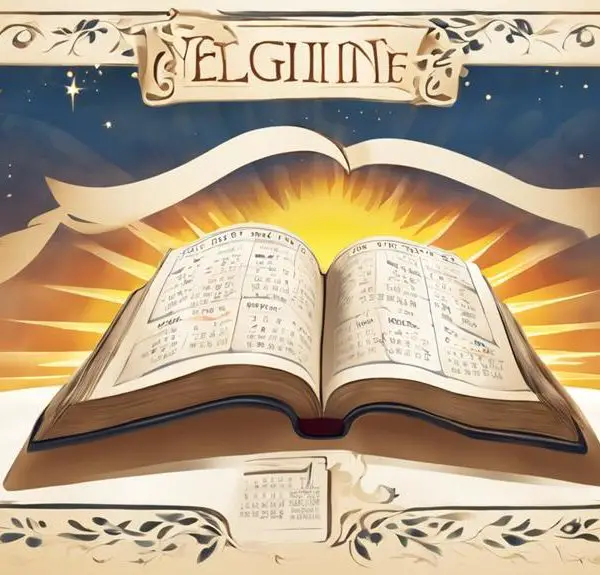Observe the 7th month's profound impact in the Bible, exploring rituals that have shaped faith and community through millennia—discover their enduring relevance.

The 7th Month in the Bible
When you hit the 'search' button in the ancient texts of the Bible, the 7th month unveils a treasure trove of spiritual significance and tradition. This period marks not just a change in the calendar, but a profound time of reflection, atonement, and celebration, deeply embedded in Jewish culture.
From the solemnity of Yom Kippur to the joyous shelters of Sukkot, these observances offer a glimpse into the rich tapestry of faith and community life.
But why have these rituals endured through millennia, and how do they resonate in today's world? You might find the continuities and evolutions both surprising and enlightening.
Key Takeaways
- The 7th month is pivotal for biblical observances, highlighting themes of gratitude and divine providence.
- It features the Day of Atonement, emphasizing reconciliation and spiritual renewal.
- Sukkot, celebrated in this month, combines agricultural appreciation with historical narratives.
- Modern practices of Sukkot adapt its traditions to foster community unity and environmental reflection.
Historical Significance

Historically, the 7th month in the biblical calendar holds significant religious and cultural importance, often marking periods of reflection and renewal in the Jewish tradition. This time of year is deeply intertwined with agricultural importance, serving as a bridge between the end of the harvest season and the onset of winter. You'll find that this period isn't just about the physical act of harvesting crops, but also carries a profound cultural symbolism, encapsulating themes of gratitude, preparation, and communal unity.
The agricultural significance of this month is undeniable, as it underscores the reliance on divine providence for sustenance and survival. The culmination of harvest activities not only ensures physical nourishment but also fosters a deep sense of gratitude towards the land and its Creator. This gratitude is reflected in various rituals and celebrations that accentuate the cultural symbolism of the month, weaving together the threads of spiritual reflection, thanksgiving, and communal responsibility.
In this context, the 7th month emerges as a pivotal time that transcends its agricultural roots to embody a broader spectrum of cultural and spiritual meanings. It's a period that invites you to pause, reflect on the blessings of the harvest, and contemplate the interconnectedness of community, faith, and the natural world.
Day of Atonement Explained
Amid the reflections and preparations of the 7th month, the Day of Atonement stands out as a profound observance, inviting deep spiritual introspection and communal repentance. At its core, atonement theology represents a multifaceted understanding of reconciliation between humanity and the divine, achieved through acts of confession, repentance, and the presentation of sin offerings. This day, more than any other in the biblical calendar, encapsulates the essence of atonement, highlighting the necessity of confronting one's failings and seeking to amend the relationship with God.
The ritual of sin offerings, integral to the Day of Atonement, serves as a tangible expression of repentance and a plea for purification. Through these offerings, you're reminded of the cost of sin and the grace that underpins forgiveness. This observance doesn't merely focus on individual transgressions but emphasizes the collective responsibility of the community to uphold a covenantal relationship with the divine.
Reflective and analytical in nature, the Day of Atonement challenges you to examine the depths of your faith, the sincerity of your repentance, and the authenticity of your commitment to spiritual renewal. It's a day that doesn't just pass; it transforms, leaving an indelible mark on your spiritual journey.
Celebrating Sukkot

Transitioning from the solemn reflections of the Day of Atonement, Sukkot invites you into a vibrant celebration of thanksgiving and remembrance, encapsulating the joy of harvest and the historical journey of the Israelites. This festival, also known as the Feast of Tabernacles, occupies a unique place in the biblical calendar, blending agricultural significance with historical narrative. It serves as a harvest festival, but its implications stretch far beyond the mere collection of crops, weaving together a tapestry of gratitude, dependence on divine providence, and communal memory.
- Harvest Festival: Sukkot marks the end of the agricultural year, celebrating the bounty of the land while acknowledging the source of all sustenance.
- Temporary Shelters: The construction of sukkahs, fragile dwellings with leafy roofs, stands as a central element, symbolizing both the fragility of life and the protection provided by faith.
- Historical Journey: It commemorates the Israelites' 40-year period of wandering in the desert, living in temporary shelters.
- Joy and Thanksgiving: While the harvest is a time of joy, Sukkot elevates this natural happiness to a spiritual plane, encouraging reflection on blessings and the cycles of nature.
In essence, Sukkot encapsulates a multifaceted celebration, intertwining joy with remembrance, and harvest with history.
Rituals and Traditions
Sukkot's rituals and traditions serve as a vivid tapestry, intricately woven with symbols that deepen one's understanding of faith, community, and the natural world. This period, rich in historical and spiritual significance, commences with meticulous feast preparations, signaling a time for renewal and reflection. The New Moon celebrations, marking the beginning of the month, intertwine with these practices, embodying a cyclical reminder of life's perpetual renewal and the importance of aligning with celestial rhythms.
The essence of Sukkot is manifest in the building of the sukkah, a temporary dwelling that symbolizes both the fragility and the resilience of existence. You're encouraged to inhabit these structures, sharing meals and stories, thus reinforcing bonds of community and collective memory. This practice, rooted in agricultural traditions, also highlights humanity's dependence on the natural world, urging a harmonious coexistence with the environment.
Through these rituals and traditions, you're invited to engage in a reflective journey, contemplating the interconnectedness of faith, community, and the earth. They provide a framework for understanding the cycles of life, the value of gratitude, and the importance of nurturing relationships, both divine and earthly. In doing so, they offer a profound perspective on the enduring relevance of these ancient practices in contemporary life.
Modern Observances

While rituals and traditions of Sukkot offer a lens into the past, modern observances highlight how these practices continue to shape and inspire contemporary Jewish life. Today, you'll find that the essence of Sukkot permeates through various global adaptations and cultural interpretations, each adding a unique layer to this ancient festival. These adaptations reflect the dynamic nature of Jewish tradition, demonstrating its capacity to evolve while maintaining its core values.
- Community Building: Sukkot encourages the strengthening of community bonds through shared meals and services in the Sukkah, adapting to local customs and incorporating regional foods.
- Environmental Consciousness: The holiday has been embraced by many as a time to reflect on sustainability and our relationship with nature, mirroring ancient agricultural roots in modern environmental activism.
- Interfaith Outreach: Sukkot has become a platform for interfaith dialogue, with many communities inviting non-Jewish neighbors to partake in Sukkah festivities, fostering understanding and unity.
- Technological Integration: The use of technology to share Sukkot experiences, from virtual Sukkah tours to online educational resources, highlights a blend of tradition and modernity.
These observances showcase a reflective and analytical approach to the continuity and adaptation of Jewish traditions in the face of an ever-changing world.
Frequently Asked Questions
How Does the 7th Month in the Biblical Calendar Correlate With Today's Gregorian Calendar?
You're delving into how the 7th month from an ancient calendar aligns with today's Gregorian system. This comparison requires understanding the month's origin and its place in historical timekeeping.
Reflecting on this, you'll find that this month, often starting in late September or early October, marks significant religious and agricultural events.
Analyzing calendar comparisons, it's evident the Gregorian October closely parallels the 7th biblical month, showcasing a fascinating blend of history and tradition.
Are There Any Dietary Restrictions or Fasting Rules Unique to the 7th Month That Aren't Discussed in the Context of Specific Holidays?
You're diving into a sea of ancient wisdom, exploring dietary laws that seem as vast as the ocean.
Within this depth, you won't find explicit dietary restrictions or fasting rules tied exclusively to the 7th month outside specific holidays.
However, seasonal recipes and agricultural practices subtly weave their way through traditions, reflecting both the time's bounty and restraint.
This analytical journey reveals the nuanced interplay between culture, faith, and the natural world, offering a reflective understanding of ancient dietary customs.
How Have Interpretations of the 7th Month's Significance Evolved in Different Jewish Sects Throughout History?
You'll find that interpretations of the 7th month's significance have greatly evolved among Jewish sects throughout history. Sectarian calendars played a crucial role in shaping these views, diverging in observance and symbolism.
Modern interpretations further reflect a dynamic understanding, influenced by both historical context and evolving religious thought. This evolution underscores a reflective dialogue within communities, pondering the month's spiritual importance amidst changing societal and theological landscapes.
In What Ways Have Non-Jewish Cultures or Religions Been Influenced by or Incorporated Aspects of the 7th Month's Celebrations or Observances?
Imagine vibrant festivals and somber ceremonies, a tapestry of cultural exchanges woven through time. Non-Jewish cultures have absorbed elements of the 7th month's observances, reflecting a rich interplay of traditions.
Artistic representations in music, literature, and visual arts often echo these ancient celebrations, showcasing their influence. This blend of practices reveals a profound respect and curiosity for shared human experiences, inviting a deeper, scholarly reflection on the universality of spiritual expressions.
What Are Some Personal or Community-Based Practices Not Tied to the Traditional Rituals That People Engage in During the 7th Month to Enhance Their Spiritual Experience?
During this period, you might find yourself engaging in nature walks or community service to deepen your spiritual experience. Nature walks allow you to reflect on the beauty and intricacy of the world, fostering a deeper connection with the environment.
Participating in community service, on the other hand, offers a tangible way to contribute to the well-being of others, enriching your sense of belonging and purpose within your community.
Conclusion
In essence, the seventh month in the biblical calendar isn't just a period marked by dates; it's a tapestry woven with rituals of reflection, atonement, and celebration.
As you delve into its historical depths and surface to its modern observances, you're embarking on a journey through time.
This month serves as a mirror, reflecting our human quest for reconciliation and joy.
In the grand scheme of things, it's a poignant reminder that to move forward, we must first look inward.



Sign up